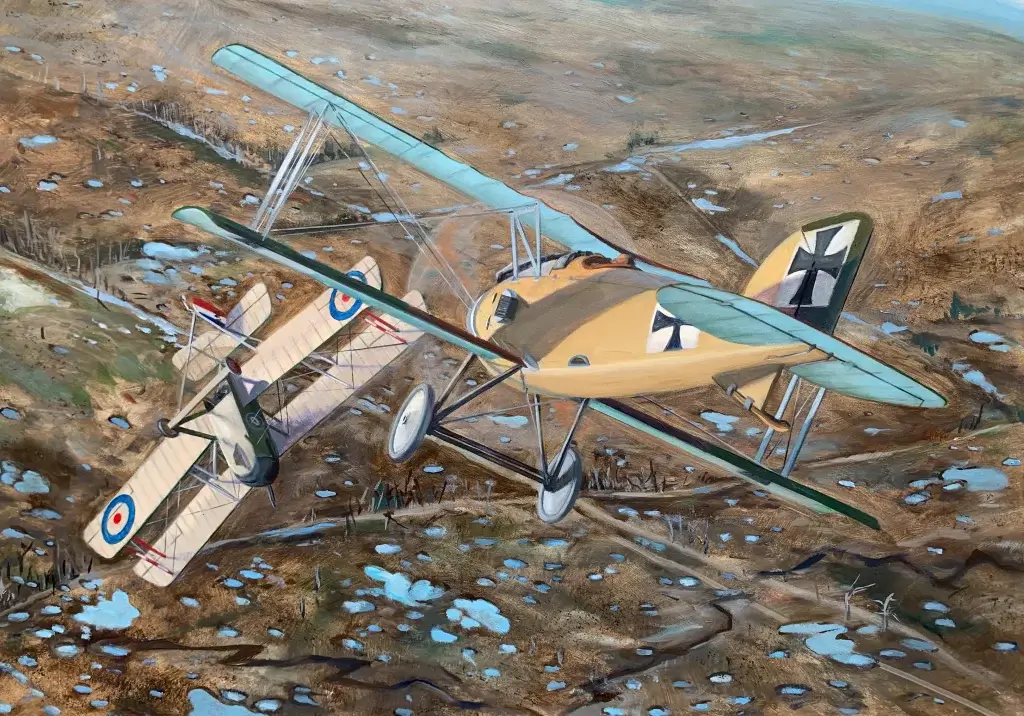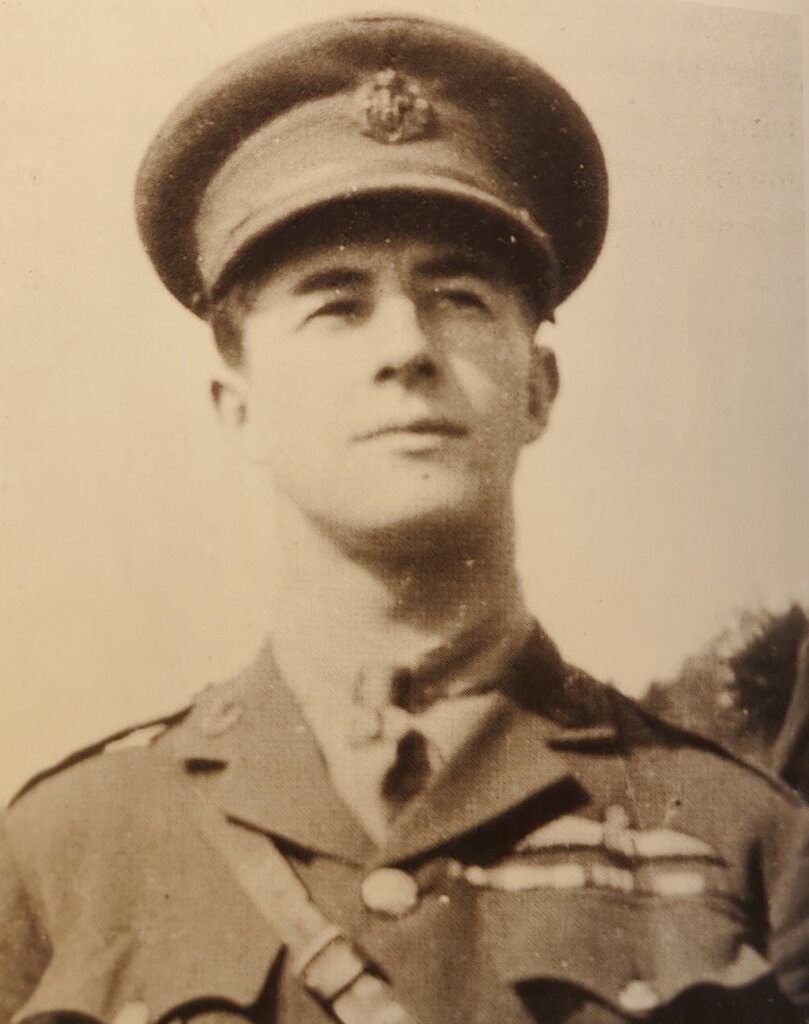Victory 15 – the reports of the English
Event ID: 773
27 December 1916
Source ID: 32
ISBN: 9781473861220
“First is a list of 29’s six pilots on this patrol, who took off from their base at le Hameau, at 1350 hours:
Name DH2 Time Down
Captain H. J. Payn 7849 1535
Lieutenant Dickson A2591 landed at le Bellevue
Lieutenant C. H. B. Readman 7855 1430 – plug trouble
Flight Sergeant J. T. B. McCudden 5985 1615
Lieutenant A. Jennings 5957 1615
Lieutenant G. R. T. Hill 7939 1520 – engine trouble
Although the Baron records his opponent as a two-seater FE, the only FE casualties this day were a machine from 11 Squadron — but the combat took place at 1115 hours — and, as already mentioned, a 20 Squadron machine, hit by ground-fire, coming down near Berthen, west of the lines, and burnt by the crew. Berthen is inland from Calais, so too far north, and the Squadron were based at Clairmarais. I believe the British translation of Manfred’s report was coloured by the belief that the ‘gitterrumpf’ referred to had to be an FE rather than a DH.2.
Captain Payn’s report:
At about 2.40pm, whilst on Offensive Patrol flying between Neuville Vitasse and Ayette, at 8,500ft I saw two machines flying close together over Boiry St Rictrude. I dived on them firing and the rest of the patrol followed. Both H.A. [Hostile Aircraft] were driven down, one appeared to be out of control, but was lost sight of before reaching the ground. They did not appear again in the locality of our patrol.
Later (about 3 pm) six Albatros scouts were patrolling at 12,000 ft to the East of us. Our A.A. batteries fired many indicating rounds.
The patrol mas then three De Havillands and two Nieuports. I fired several rounds up at the H.A. scouts hoping to get them down to our level, then being about 11,000ft.
About 3 pm I saw a Walfish scout flying S. below at 9,000 ft. I dived firing several rounds at about 150 yds range.
When again at 10,500 ft the H.A. which kept splendid formation dived onto the nearest De Havilland. One H.A. would leave the formation and attack, expending a few rounds in diving. Finally the six Scouts attacked and many rounds were fired under 50 yds range. I observed only three De Havillands and one Nieuport in this attack. One De Havilland went down in a left hand spin with the H.A. Scout following. I dived after the latter and fired my remaining shots into him whereupon he left the De Havilland.
Having no further ammunition and unable to use the main tank, I fired a green light [signal flare] and came home.
Second Lieutenant A. Jennings’ report:
Six HA. patrolling up and down the lines parallel to us and gradually approaching nearer. About 3 pm they began making dives at us firing at long range. I fired a few rounds in return, then one of our machines turned while me were over Adinfer Wood and went South. The rest of the patrol followed. Two H.A. dived at the leading De Havilland. I dived on one of the H.A. and got off some 20 rounds. While doing this another 11.A. appeared from half right. I turned towards it and fired at very short range. I could plainly see the pilot, then two H.A, got on my tail and another De Havilland drove them off. My engine cut out and, thinking the petrol pipe cut, I made for the lines. In a minute or so my engine came on again. I turned round and saw one De Havilland apparently in a spin with an H.A.. in pursuit. I went down and the H.A. went off. The De Havilland regained control and two Nieuports then appeared and the H.A. drew off.
NIcCudden’s report:
Going east of Adinfer I saw five H.A. Lt Jennings attacked a H.A. and another H.A. was approaching from behind. I fired about 15 shots and drove him off. He turned and came towards me, firing. I opened fire at 100 yds and after about eight shots my gun stopped, due to a cross-feed. As the hostile machine was engaging me at close range, I turned on my back and dived vertically, in a slow spin and in this regained our lines. At 800ft, over Passeux the H.A. left me. I quickly rectified the stoppage and followed the H.A. across the trenches at 2,000 ft. Owing to his speed and climb he outdistanced me and rejoined his patrol at about 5,000 ft. The hostile patrol then withdrew.
It would seem that McCudden had driven off von Richthofen’s attack on Jennings and, shortly afterwards, Jennings saw McCudden spinning earthwards, being followed by the Baron. No doubt the latter, realising he was near the front lines, quickly decided to head back into German-held territory, and probably was not aware that McCudden, having pulled out of his spin, was attempting to follow. It would also seem that von Richthofen, believing his opponent was just moments away from smashing into the ground, brought this wishful thinking into his combat report. Once the Jasta had telephoned the front-line observers to ask if they had seen a gitterrumpf going down in a spin, and they reported that they had, the ‘confirmation’ was complete. Had they also reported that the enemy machine was a DH.2, von Richthofen’s report would have recorded this rather than an FE.2, i.e. a single-seater rather than a two-seater. There is, of course, no answer to him saying that the machine was smashed and therefore the serial number was unrecognisable. As it would have ‘fallen’ inside British lines, he would not know how unrecognisable it was.
In his book Flying Fury, McCudden states:
I now fired at the nearest Hun who was after Jennings, and this Hun at once came for me nose on, and we both fired simultaneously, but after firing about twenty shots my gun got a bad double feed, which I could not rectify at the time as I was now in the middle of five D.I Albatroses, so I half-rolled. When coming out I kept the machine past vertical for a few hundred feet and had started to level out again, when, ‘cack, cack, cack, cack’, came from just behind me. I immediately half-rolled again, but still the Hun stayed there, and so whilst half-rolling, I kept on making headway for our lines, for the fight had started east of Adinfer Wood, with which we were so familiar on our previous little joy-jaunts.
I continued to do half-rolls and got over the trenches at about 2,000 feet, with the Hun still in pursuit, and the rascal drove me down to 800 feet a mile west of the lines, when he turned off east, and was shelled by our A.A. guns. I soon rectified the jam and turned to chase the Hun, but by this time the Hun was much higher, and very soon joined his patrol, who were waiting for him at about 5,000 feet over Rancourt.”


Comments (0)